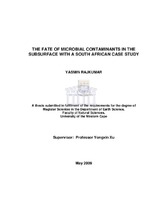| dc.contributor.advisor | Xu, Yongxin | |
| dc.contributor.author | Rajkumar, Yasmin | |
| dc.contributor.other | Dept. of Earth Science | |
| dc.contributor.other | Faculty of Science | |
| dc.date.accessioned | 2014-02-03T10:03:39Z | |
| dc.date.available | 2010/06/28 22:22 | |
| dc.date.available | 2010/06/28 | |
| dc.date.available | 2014-02-03T10:03:39Z | |
| dc.date.issued | 2009 | |
| dc.identifier.uri | http://hdl.handle.net/11394/2692 | |
| dc.description | Magister Scientiae - MSc | en_US |
| dc.description.abstract | The time bound agenda of the Millennium Development Goals (MDG's) aims at reducing poverty, extending gender equality and advancing opportunities for health and education by addressing current and future water resource and sanitation needs. In many rural areas of South Africa, the cost implication of routing surface water supplies and providing water borne sewerage may far exceed the budgets of local water service authorities. This has resulted in a major thrust in service provision via localised sources, mainly boreholes and springs as well as on site sanitation options. Whilst the National Water Act (Act 36 of 1998) mandates the South African government to provide potable water to all citizens in an equitable manner, this needs to be balanced against the preservation of the country’s water resources both quantitatively and qualitatively to ensure sustainability. It is imperative that this fine balance between protection and effecting societal demands and economic development through large-scale water provision be maintained, as successful strategising will be resultant of integrated social, economic and environmental issues especially in economically developing countries. In order to fulfil the mandate of the NWA, policies and strategies for effective protection and use of groundwater resources have been drawn up and are in the process of being drawn up by the national Department of Water Affairs and Forestry (DWAF). The major scope of research in this thesis stems from feasibility studies commissioned by the DWAF for the implementation of a groundwater protection zoning policy for the management and protection of groundwater resource quality. The research work focuses on specifically the microbiological zone of protection and attempts to determine the fate of various pathogens that emanate from on site sanitation facilities as they move through the subsurface. The research was predominantly proposed as a desktop collation and analysis of existing published data however; it was later decided to include a local case study site. | en_US |
| dc.language.iso | en | en_US |
| dc.publisher | University of the Western Cape | en_US |
| dc.subject | Pathogens | en_US |
| dc.subject | Viruses | en_US |
| dc.subject | Bacteria | en_US |
| dc.subject | Faecal and total coliforms | en_US |
| dc.subject | Groundwater quality | en_US |
| dc.subject | Groundwater protection zones | en_US |
| dc.subject | Microbial subsurface transport | en_US |
| dc.subject | Attenuation rates | en_US |
| dc.subject | Indicator pathogens | en_US |
| dc.subject | Phelendaba | en_US |
| dc.subject | Kwa-Zulu Natal | en_US |
| dc.title | The fate of microbial contaminants in the subsurface with a South African case study | en_US |
| dc.type | Thesis | en_US |
| dc.rights.holder | University of the Western Cape | en_US |
| dc.description.country | South Africa | |

